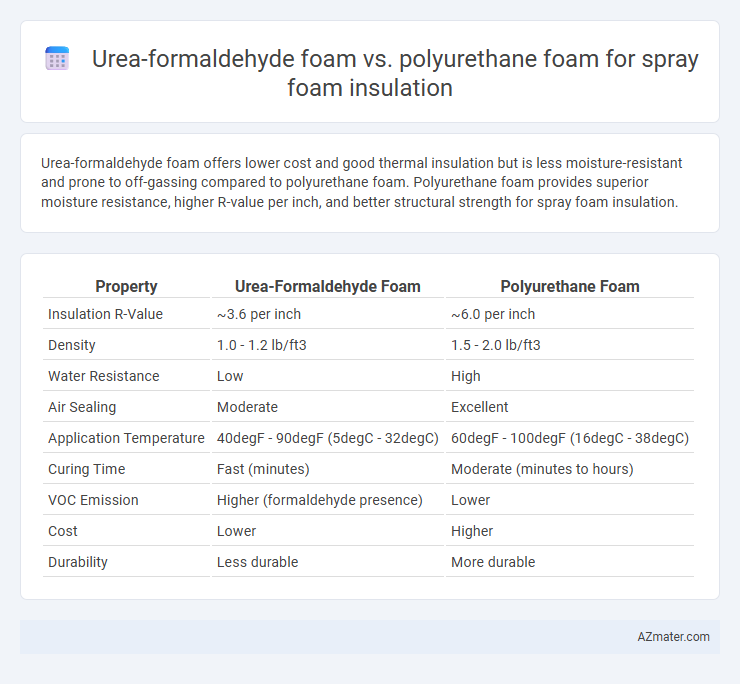Urea-formaldehyde foam offers lower cost and good thermal insulation but is less moisture-resistant and prone to off-gassing compared to polyurethane foam. Polyurethane foam provides superior moisture resistance, higher R-value per inch, and better structural strength for spray foam insulation.
Table of Comparison
| Property | Urea-Formaldehyde Foam | Polyurethane Foam |
|---|---|---|
| Insulation R-Value | ~3.6 per inch | ~6.0 per inch |
| Density | 1.0 - 1.2 lb/ft3 | 1.5 - 2.0 lb/ft3 |
| Water Resistance | Low | High |
| Air Sealing | Moderate | Excellent |
| Application Temperature | 40degF - 90degF (5degC - 32degC) | 60degF - 100degF (16degC - 38degC) |
| Curing Time | Fast (minutes) | Moderate (minutes to hours) |
| VOC Emission | Higher (formaldehyde presence) | Lower |
| Cost | Lower | Higher |
| Durability | Less durable | More durable |
Introduction to Spray Foam Insulation
Spray foam insulation primarily consists of Urea-formaldehyde foam and Polyurethane foam, both offering distinct thermal and air-sealing properties. Urea-formaldehyde foam is an early-generation material known for its cost-effectiveness and fire resistance, commonly used in indoor applications with moderate R-values. Polyurethane foam, favored for its superior insulation performance and higher R-values per inch, provides excellent moisture resistance, making it suitable for a wide range of residential and commercial spray foam insulation projects.
Overview of Urea-Formaldehyde Foam
Urea-formaldehyde foam insulation (UFFI) is a rigid, low-density spray foam primarily used in wall cavities, known for its quick curing time and cost-effectiveness compared to polyurethane foam. It offers excellent thermal insulation with an R-value typically around 3.7 per inch, but emits trace formaldehyde gas, which may pose indoor air quality concerns without proper ventilation. UFFI has largely been replaced by polyurethane foam, which provides higher R-values and moisture resistance, but it remains relevant in specific retrofit applications and budget-sensitive projects.
Overview of Polyurethane Foam
Polyurethane foam is a versatile spray foam insulation known for its high R-value, typically ranging from 6 to 7 per inch, providing superior thermal resistance. It offers excellent air sealing properties and moisture resistance, making it suitable for various building applications including walls, roofs, and crawl spaces. Compared to urea-formaldehyde foam, polyurethane foam has a longer lifespan and lower potential for off-gassing, enhancing indoor air quality and durability.
Thermal Performance Comparison
Urea-formaldehyde foam offers a thermal conductivity (k-value) typically around 0.024-0.030 W/m*K, providing effective insulation but with slightly lower R-values compared to polyurethane foam, which ranges from 0.020 to 0.025 W/m*K. Polyurethane foam's superior closed-cell structure results in higher R-values per inch (approximately R-6 to R-7) compared to urea-formaldehyde foam (around R-4.5 to R-5.5), enhancing energy efficiency in colder climates. The moisture resistance of polyurethane foam also maintains its thermal performance over time better than urea-formaldehyde, which can be susceptible to moisture-induced degradation.
Air Sealing and Moisture Resistance
Urea-formaldehyde foam offers excellent air sealing properties due to its closed-cell structure, which effectively reduces air infiltration and improves indoor air quality. Polyurethane foam also provides superior air sealing with higher R-values per inch, enhancing energy efficiency while maintaining a strong barrier against air leaks. For moisture resistance, polyurethane foam excels by resisting water absorption and preventing mold growth, whereas urea-formaldehyde foam is more susceptible to moisture-related degradation and potential off-gassing issues.
Installation Process Differences
Urea-formaldehyde foam requires precise mixing of two components on-site, demanding trained installers to maintain chemical ratios and proper temperature for effective curing. Polyurethane foam is generally faster to apply as it comes pre-mixed in pressurized cylinders or tanks, allowing for more straightforward spray application and rapid expansion. Urea-formaldehyde's installation involves more careful ventilation due to higher formaldehyde emissions during curing, whereas polyurethane foam installs with fewer off-gassing concerns in modern formulations.
Safety and Health Considerations
Urea-formaldehyde foam releases formaldehyde gas, which poses respiratory risks and potential carcinogenic effects during and after installation, requiring strict ventilation and personal protective equipment (PPE). Polyurethane foam emits isocyanates, which can cause asthma and skin sensitization, but low-VOC formulations and proper curing reduce these hazards significantly. Both materials demand careful handling, but polyurethane foam with appropriate controls offers a safer long-term indoor air quality profile compared to urea-formaldehyde foam.
Environmental Impact and Sustainability
Urea-formaldehyde foam releases formaldehyde gas, contributing to indoor air pollution and posing health risks, while polyurethane foam has lower VOC emissions but relies on petroleum-based chemicals. Both materials have environmental concerns; urea-formaldehyde foams decompose more easily but can off-gas toxic substances, whereas polyurethane foams offer superior insulation efficiency, reducing energy consumption over the building's life cycle. Sustainable alternatives and advancements focus on bio-based polyurethanes and formaldehyde-free formulations to minimize ecological footprint and improve indoor air quality.
Cost Comparison and Long-Term Value
Urea-formaldehyde foam typically offers a lower upfront cost compared to polyurethane foam, making it a budget-friendly option for spray foam insulation projects. Polyurethane foam, despite its higher initial price, provides superior durability, moisture resistance, and thermal insulation performance, resulting in greater long-term energy savings and reduced maintenance costs. Considering overall long-term value, polyurethane foam often delivers a better return on investment due to its longevity and enhanced insulation efficiency.
Choosing the Right Insulation for Your Needs
Urea-formaldehyde foam offers excellent soundproofing and fire resistance but produces formaldehyde gas, which requires proper ventilation during installation. Polyurethane foam delivers superior thermal insulation with higher R-values and better moisture resistance, making it ideal for energy-efficient buildings. Selecting the right spray foam insulation depends on factors like environmental sensitivity, building codes, and desired insulation performance.

Infographic: Urea-formaldehyde foam vs Polyurethane foam for Spray foam insulation
 azmater.com
azmater.com